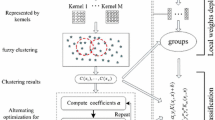Abstract
In this paper, we have focused on the use of the support vector data description based on kernel-based possibilistic c-means algorithm (PCM) for solving multi-class classification problems. We propose a weighted support vector data description (SVDD) multi-class classification method, which can be used to deal with the outlier sensitivity problem in traditional multi-class classification problems. The proposed method is the robust version of SVDD by assigning a weight to each data point, which represents fuzzy membership degree of the cluster computed by the kernel-based PCM method. Accordingly, this paper presents the multi classification algorithm and gives the simple classification rule, which satisfies Bayesian optimal decision theory. With a simple classification rule, our experimental results show that the proposed method can reduce the effect of outliers and reduce the rate of classification error.
Similar content being viewed by others
References
Hsu C.W., Lin C.J. (2002). A comparison of methods for multi-class support vector machines. IEEE Transactions on Neural Networks 13(2): 415–425
Hu W.J., Song Q. (2004). An accelerated decomposition algorithm for robust support vector machines. IEEE Transactions on Circuits and Systems II: Express Briefs 51(5): 234–240
Inoue, T., & Abe, S. (2001). Fuzzy support vector machines for pattern classification. In Proceedings of International Joint Conference on Neural Networks Vol. 2. pp. 1449–1454.
Krishnapuram R., Keller J. M. (1993). A possibilistic approach to clustering. IEEE Transactions on Fuzzy System 1(2): 98–110
Krishnapuram R., Keller J.M. (1996). The possibilistic c-means algorithm: Insights and recommendations. IEEE Transactions on Fuzzy System 4(3): 385–393
Lee D., Lee J. (2007). Domain described support vector classifier for multi-classification problems. Pattern Recognition 40, 41–51
Lin C.F., Wang S.D. (2002). Fuzzy support vector machines. IEEE Transactions on Neural Networks 13(2): 464–471
Lin, C. F., & Wang, S. D. (2003). Training algorithms for fuzzy support vector machines with noisy data. In: Proceedings of the IEEE 8th Workshop on Neural Networks for Signal Processing, pp. 517–526.
Muller K.R., Mike S., Ratsch G., Tsuda K., Schölkopf B. (2001). An introduction to kernel based learning algorithms. IEEE Transactions on Neural Networks 12(2): 181–201
Platt, J. C., Cristianini, N., & Shawe-Taylor, J. (2002). Large margin DAG’s for multiclass classification. In S. A. Solla, T. K. Leen, & K. R. Müller (Eds.), Advances in Neural Information Processing Systems (Vol. 12). pp. 547–553.
Schölkopf, B., Burges, C., & Vapnik, V. N. (1995). Extracting support data for a given task. In Proceedings of First International Conference on Knowledge Discovery and Data Mining, pp. 252–257.
Schölkopf B., Platt J., Shawe-Taylor J., Smola A.J., Williamson R.C. (2001). Estimating the support of a high-dimensional distribution. Neural Computation 13(7): 1443–1471
Schölkopf B., Smola A.J. (2002). Learning with Kernels. Cambridge, MA, MIT Press
Song Q., Hu W.J., Xie W.F. (2002). Robust support vector machine with bullet hole image classification. IEEE Transactions on Systems, Man and Cybernetics 32(4): 440–448
Tax D., Duin R. (2004). Support vector data description. Machine Learning 54, 45–66
Vapnik V.N. (1995). The Nature of Statistical Learning Theory. New York, Springer
Wang J., Neskovic P., Cooper L.N. (2007). Bayes classification based on minimum bounding spheres. Neurocomputing 70, 801–808
Weston, J., & Watkins, C. (1998). Multi-class support vector machines. Department of Computer Science, Royal Holloway University of London Technical Report, SD2TR298204.
Zhang Y., Chi Z.X., Liu X.D., Wang X.H. (2007). A novel fuzzy compensation multi-class support vector machines. Applied Intelligence 27(1): 21–28
Zhu, M. L., Chen, S. F., & Liu, X. D. (2003). Sphere-structured support vector machines for multi-class pattern recognition. In Lecture Notes in Computer Science (Vol. 2639). pp. 589–593.
Author information
Authors and Affiliations
Corresponding author
Rights and permissions
About this article
Cite this article
Zhang, Y., Chi, ZX. A Fuzzy support vector classifier based on Bayesian optimization. Fuzzy Optim Decis Making 7, 75–86 (2008). https://doi.org/10.1007/s10700-007-9025-7
Published:
Issue Date:
DOI: https://doi.org/10.1007/s10700-007-9025-7




